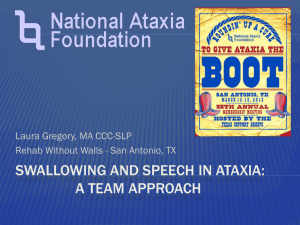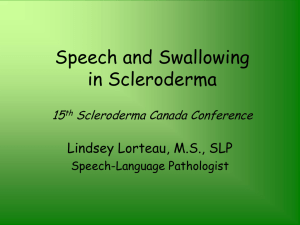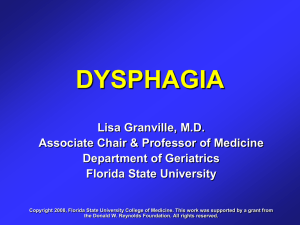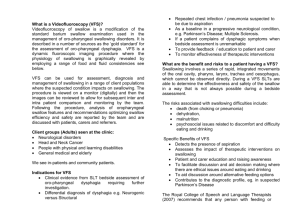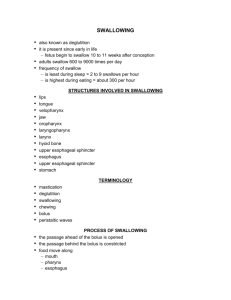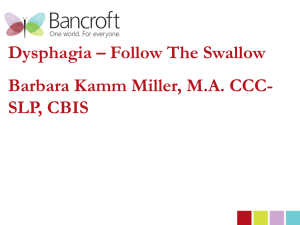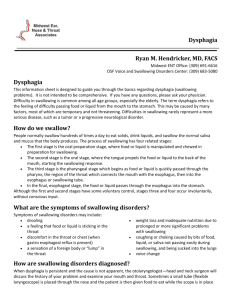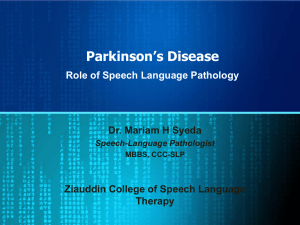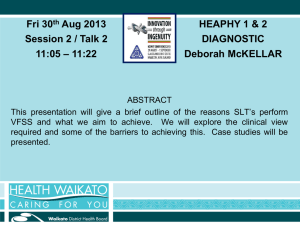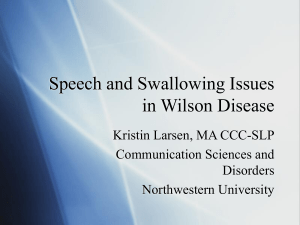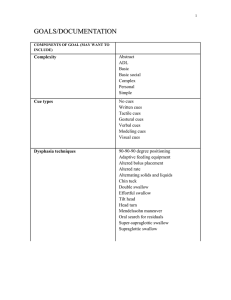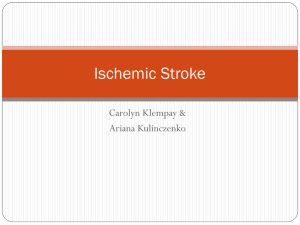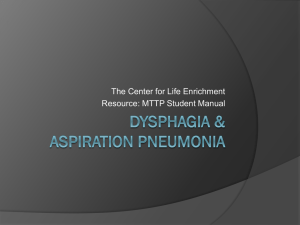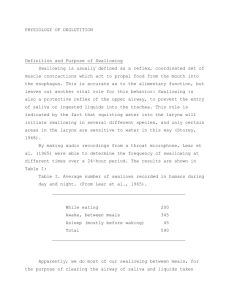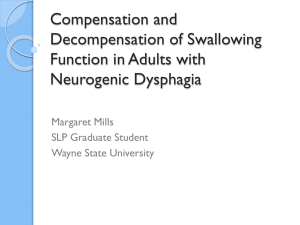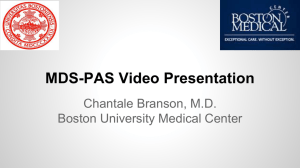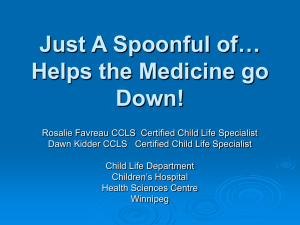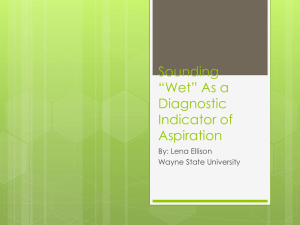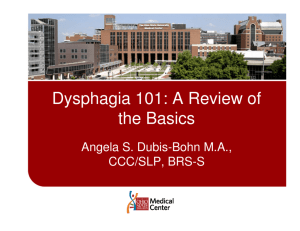Speech & Swallowing - National Ataxia Foundation
advertisement
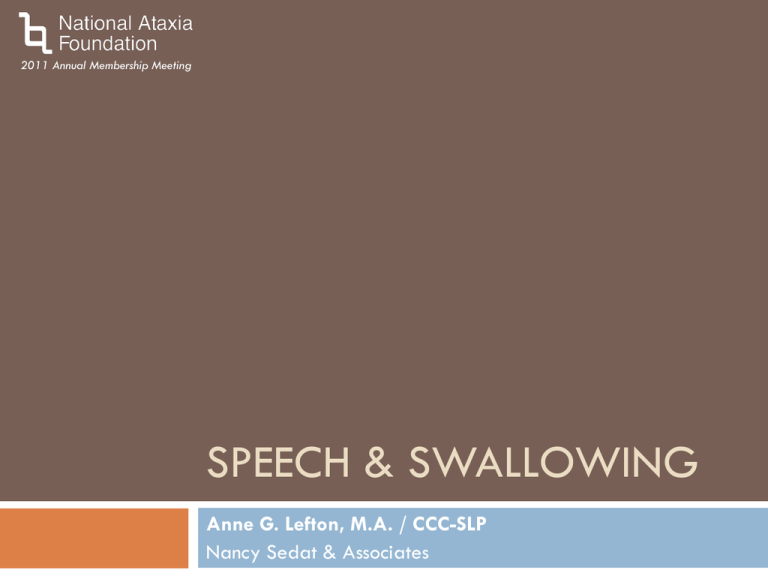
2011 Annual Membership Meeting SPEECH & SWALLOWING Anne G. Lefton, M.A. / CCC-SLP Nancy Sedat & Associates “It feels like there’s something stuck in my throat!” Swallowing Transference of material from: Mouth Esophagus Throat Stomach 3 Phases of Swallowing Oral Pharyngeal Esophageal Normal Swallow Sequence Normal Swallow Sequence In the mouth: lips, teeth and tongue help prepare bolus (food mass) for further stages of swallowing. Lips Teeth Tongue Bolus Normal Swallow Sequence Access between the nasal cavity and mouth closes as bolus moves into pharynx (throat). Nasal Cavity Pharynx Bolus Normal Swallow Sequence Bolus is propelled esophagus As esophagus entrance opens: Epiglottis helps guard against access to the lungs. Epiglottis Vocal Cords Trachea/Airway to the Lungs Esophagus Entrance Normal Swallow Sequence The airway reopens and the esophagus entrance closes as muscle contractions move bolus toward stomach. To the Stomach Swallowing Disorders Swallowing Disorders / Dysphagia Oral Stage Difficulty bolus controlling, forming, or transporting a cohesive Swallowing Disorders / Dysphagia Pharyngeal Stage Pooling or Stasis Aspiration Illustrations by Elliot Sheltman from Follow the Swallow by Jo Puntil-Sheltman Evaluation of Swallowing Function Non-instrumental clinical evaluation Instrumental assessment Modified aka: Barium Swallowing Study (MBSS) Videofluoroscopic Swallowing Examination Fiberoptic Endoscopic Evaluation of Swallowing (FEES) Thin Liquid Swallows Puree Swallows Cookie Swallows Complications from Dysphagia Pneumonia Risk increases as dysphagia worsens Choking Longer Meal Times Malnutrition Dehydration Weight Loss Quality of Life Loss of social interaction associated w/ eating Treatment What to Do? Immediate remedies: 1. 2. 3. 4. 5. If coughing/choking, never inhibit cough Heimlich Maneuver Stack breathing Portable suction CoughAssist device [www.respironics.com] CoughAssist™ Mechanical In-Exsufflator Safe Swallowing Strategies Swallowing techniques Don’t talk with mouth full Repeat swallows Alternate solids and liquids One Sip sip at a time ‘n’ tip straws Smaller bites Slowed rate Supervision and cueing Smaller, more frequent meals per day Safe Swallowing Strategies [cont.] Changes in food & liquid consistencies Avoid problem textures and consistencies Gel/powder liquid thickener Diet Hierarchy Steak consistency diet Pot roast consistency diet Meat loaf consistency diet Pudding consistency diet Cream consistency diet (tube feedings) Safe Swallowing Strategies [cont.] Positioning Chin tuck Behavioral changes Reduce distractions Eat more calories early in the day or when there is less fatigue Safe Swallowing Strategies [cont.] Pill management Take with applesauce, yogurt, pudding, ice cream, or any other slippery medium Cool Whip! Long-necked bottles Carbonated beverages Crush with pharmacist’s consent Alternative Methods of Nutrition Feeding Tubes G-tube goes into stomach through an opening in skin Feeding Tubes [cont.] What it does: Provides nutrition via an alternate route Allows one to receive required nutrition and hydration when no diet texture can be swallowed safely or when oral feeding is not meeting nutritional / hydration needs Allows for the combination of oral eating for pleasure and tube feeding for fluids and calories Ataxia and Speech Speech “Normal” sounding speech requires perfect coordination of the following systems: Articulatory system (e.g., lips, tongue, etc.) Resonatory system (e.g., velum/soft palate) Phonatory system (e.g., vocal cords) Respiratory system (e.g., lungs) Random Speech Facts… Approx. 14 different sounds produced every second when we verbalize. Over 100 different muscles coordinate during speech. “Its Greek to Me” Ataxia comes from: Greek word for “lack of order” Ataxic Dysarthria Disorder of sensorimotor control for speech production that results from damage to cerebellum or to its input and output pathways Effects of Ataxia on Speech Effects of Ataxia on Speech Articulation: disruption of the timing, force, range, and direction of movements. Imprecise consonant articulation Distorted vowels Breakdown is most evident during longer strings of speech Effects of Ataxia on Speech [cont.] Resonance: Hypernasality Hyponasality May occur due to timing errors between the muscles of the velum and the other muscles of articulation. Soft Palate / Velum Effects of Ataxia on Speech [cont.] Phonation: the sound of the voice Harsh due Vocal vocal quality to decreased muscle tone tremor Effects of Ataxia on Speech [cont.] Respiration: Uncoordinated Exaggerated movements of the respiratory muscles movements Excessive loudness Paradoxical movements (different muscle groups work against each other) Talking too quickly Decreased vocal volume Trying to talk on residual air Most Common Speech Changes Imprecise consonants Excess and equal stress Articulatory breakdown Distorted vowels Harsh vocal quality Mono pitch/Mono loudness Slowed speech rate Treatment What to do about it… 1. Evaluation by a Speech-Language Pathologist 2. Treatment Exercises Improve will target the affected system(s) breath support and coordination of breathing and speaking Rate control techniques (e.g., finger/hand tapping to set the pace of appropriate syllable production) Increase articulatory accuracy: over-articulate Develop stress and intonation skills to regulate pitch and loudness Compensatory Strategies For the Speaker... Energy conservation Minimize environmental noise/distractions Establish context of message Alter your rate of speech…SLOW it down. Exaggerate articulation of final consonants in words Use gestures/point to props Boil down the message decrease “filler” words Keep important/key words Compensatory Strategies For the Communication Partner… Ascertain patients preferred strategy when not intelligible Decrease the need for repetition fatigue and frustration Ask yes/no questions Know the topic Maintain eye contact Give undivided attention Don’t interrupt or finish sentences Let the speaker know the parts of the message you did not understand so s/he will not have to repeat the entire message. Patience Augmentative/Alternative Communication (AAC) Low tech Communication board Alphabet board Phrase board High tech Speech generating devices An SLP can help explore your options Other Voice amplification Chattervox OR SoniVox Take Home Message With regard to speech or swallowing, there is always a way to keep you functioning at the highest level possible. 2011 Annual Membership Meeting THANK YOU! Anne G. Lefton, M.A. / CCC-SLP Nancy Sedat & Associates References Freed, D. (2000). Motor speech disorders diagnosis and treatment. San Diego, CA: Singular Thomson Learning, 2000. Puntil-Sheltman, J. (1997). Follow the swallow. Seal Beach, CA: Sheltman Publishing, 37-40. Rangamani, G.N., J. (2006). Managing speech and swallowing problems: A guidebook for people with ataxia. National Ataxia Foundation, 1-60. Yorkston, K.M., Beukelman, D.R., & Bell, K. (1988). Clinical management of dysarthric speakers. San Diego, CA: College-Hill Press.
![Dysphagia Webinar, May, 2013[2]](http://s2.studylib.net/store/data/005382560_1-ff5244e89815170fde8b3f907df8b381-300x300.png)
